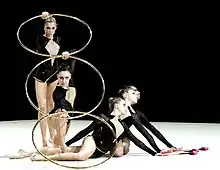Hoop (rhythmic gymnastics)
History
At the end of the 19th century, a movement known as "The Physical Culture Movement". This movement was an effort to promote physical fitness for everyone and included challenging exercises to increase body strength, flexibility, and overall fitness. This quickly grew to popularity as students were to be strong and healthy. Johann Christoph Guts Muths and Friedrich Ludwig Jahn, the fathers of German gymnastics, encouraged people to exercise using items such as medicine balls and dumbells.[1]

Description
A hoop is an apparatus in rhythmic gymnastics and may be made of plastic or wood, provided that it retains its shape during the routine. The interior diameter is from 51 cm (20 in) to 90 cm (35 in), and the hoop must weigh a minimum of 300 grams (11 oz). The hoop may be of a natural colour or be partially of fully covered by one or several colours, and it may be covered with adhesive tape either of the same or different colour as the hoop.
Fundamental requirements of a hoop routine include rotation around the hand or body and rolling, as well as swings, circles, throws, and passes through and over the hoop.
Many of the techniques of rhythmic gymnastics have been adopted by the modern hooping community.
References
- RG, Melody (2021-04-10). "The Origins of Rhythmic Gymnastics". Melody and Rhythmic. Retrieved 2023-04-11.
 Media related to Hoop (rhythmic gymnastics) at Wikimedia Commons
Media related to Hoop (rhythmic gymnastics) at Wikimedia Commons